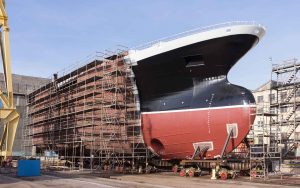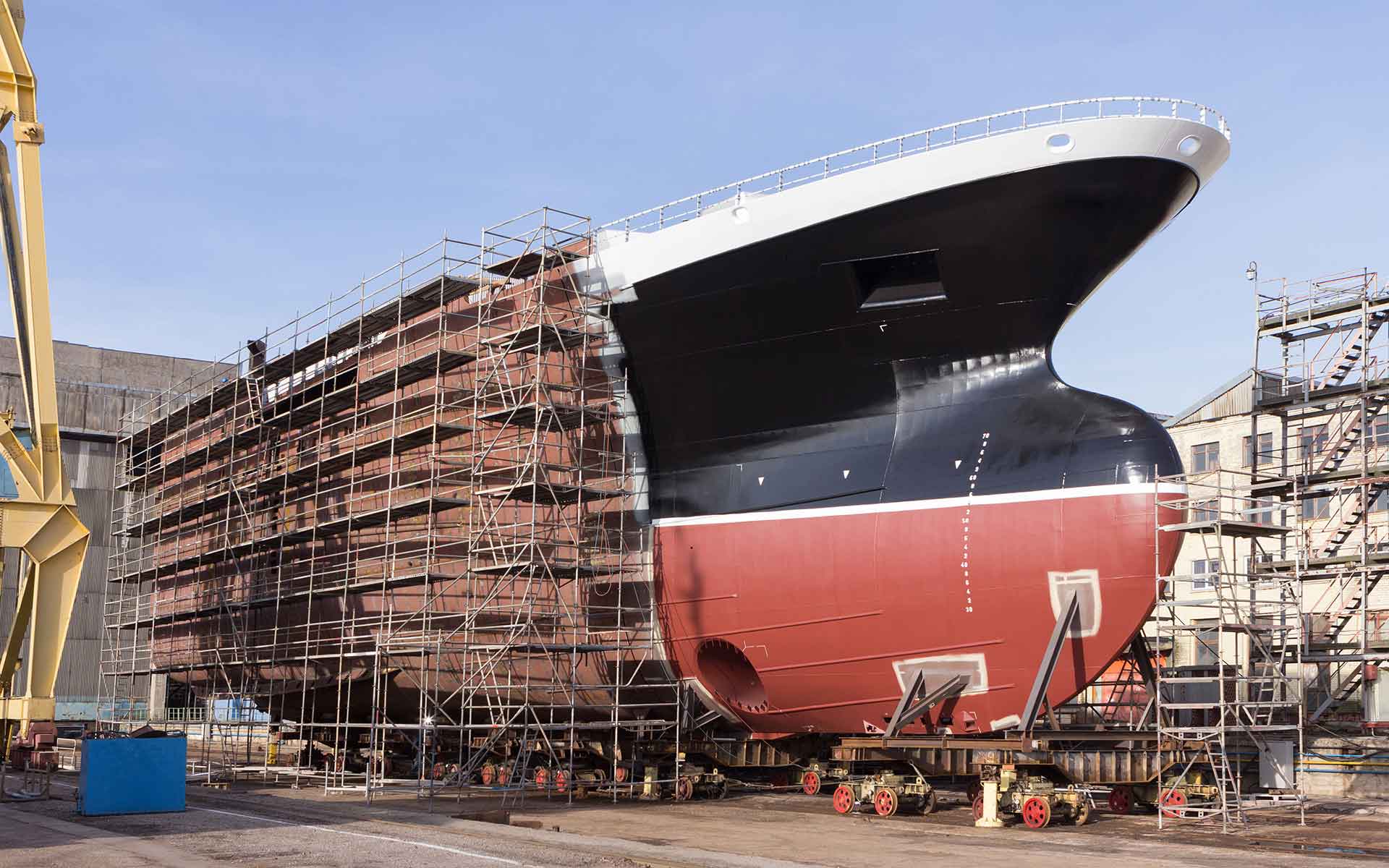Naval architecture and ship construction are key areas of knowledge for ship engineering officers, as they directly influence the performance, safety, and efficiency of the vessel. Understanding how ships are designed and built allows officers to appreciate the underlying principles that affect a ship’s stability, buoyancy, and structural integrity. This knowledge is essential not only for maintaining the vessel’s condition but also for making informed decisions during repairs, retrofitting, or modifications. In this chapter, we will explore the core concepts of naval architecture and ship construction, focusing on how they relate to the practical responsibilities of ship engineering officers.

Basic Principles of Ship Stability
Ship stability is one of the most critical aspects of naval architecture, as it directly impacts the vessel’s safety and operational capability. Stability ensures that the ship can return to an upright position after being tilted by external forces such as wind, waves, or the ship’s own movement.
- Buoyancy
Buoyancy refers to the force that keeps a ship afloat. It is governed by Archimedes’ Principle, which states that a floating object displaces a volume of water equal to its weight. For a ship to float, its overall weight (including cargo, fuel, and the structure itself) must be less than the weight of the water it displaces. Engineering officers must monitor the ship’s displacement and ensure it remains within safe limits, particularly when loading cargo or managing ballast water. - Trim and List
Trim refers to the balance of a ship along its longitudinal axis, from bow to stern. A ship is said to be in trim when it sits level in the water, with equal draught at both ends. Changes in trim can occur due to cargo distribution or fuel consumption. List, on the other hand, refers to a tilt along the ship’s lateral axis, usually caused by uneven weight distribution or water ingress. Officers must use ballasting systems and adjust cargo placement to correct excessive trim and list, ensuring the vessel operates safely. - Stability Calculations
Stability is quantified using metrics such as the metacentric height (GM), which measures the distance between the center of gravity (G) and the metacenter (M), a point where the buoyant force acts. A positive GM indicates that the ship will return to an upright position after tilting, while a negative GM means the ship is unstable and may capsize. Officers use stability calculations to ensure the ship’s loading condition keeps GM within safe limits. These calculations are critical when dealing with heavy cargo, large open deck spaces, or complex loading scenarios.
Buoyancy, Trim, List, and Stability Calculations
Maintaining the correct balance of buoyancy, trim, and stability is essential for the safe operation of any vessel. These principles must be carefully managed throughout the voyage, particularly during loading and unloading, as the ship’s condition changes.
- Load Lines and Draught Marks
Load lines, also known as Plimsoll lines, indicate the maximum safe draught of a ship under different conditions (such as freshwater, saltwater, or tropical zones). Draught marks are painted on the hull at the bow and stern, allowing officers to monitor how deeply the ship sits in the water. Excessive draught can lead to unsafe sailing conditions, particularly in shallow waters or during heavy weather. Engineering officers are responsible for ensuring that the ship’s load complies with load line regulations, as overloading can compromise buoyancy and stability. - Ballast Systems
Ballast tanks play a crucial role in managing the ship’s stability. By adjusting the volume of water in ballast tanks, officers can control the ship’s trim, list, and overall stability. This is especially important during cargo operations, where uneven loading can lead to excessive list or trim. Ballast management systems also help to comply with environmental regulations, such as those governing ballast water discharge to prevent the spread of invasive species.
Structural Design of Ships
The structural design of a ship must ensure that it can withstand the forces it encounters during its operational life, including waves, cargo loads, and vibrations from engines. Ship engineering officers must be familiar with the fundamental aspects of structural design to understand how various parts of the ship work together to maintain integrity and safety.
- Hull Structure
The hull is the outer shell of the ship that provides buoyancy and protects against the external marine environment. The strength of the hull is critical, as it must withstand forces from waves, cargo, and the internal pressures of fluids. Engineering officers must regularly inspect the hull for signs of corrosion, cracks, or other damage that could compromise its integrity. Understanding the materials used in hull construction, such as steel or aluminum, is important for determining the appropriate maintenance and repair techniques.Longitudinal and Transverse Frames: The hull is reinforced by longitudinal and transverse frames, which give it strength and rigidity. These frames are key components of the ship’s skeleton, helping to distribute the stresses caused by the ship’s weight, cargo, and the sea’s motion. Officers need to monitor these structural elements, especially in areas like the keel and deck, where bending and torsional stresses are highest. - Bulkheads and Watertight Compartments
Bulkheads divide the ship into watertight compartments, which help to maintain buoyancy and stability in the event of a hull breach. These compartments can prevent flooding from spreading throughout the ship, improving survivability in case of an accident. Ship engineers must ensure that watertight doors are functioning properly and that bulkheads are free from damage or corrosion. Regular testing and maintenance of watertight seals are essential for safety. - Keel and Deck
The keel is the central structural element running along the bottom of the ship. It acts as the ship’s backbone, providing longitudinal strength and helping to keep the vessel upright. The deck, on the other hand, provides horizontal strength and supports the ship’s superstructure. Damage to the keel or deck can compromise the ship’s stability and structural integrity, so engineering officers must be vigilant in inspecting these areas for wear, fatigue, or deformation.
Materials Used in Shipbuilding
The materials used in ship construction have a significant impact on the ship’s performance, longevity, and maintenance requirements. Engineering officers must be familiar with these materials to ensure proper care and repair of the ship’s structure.
- Steel
Steel is the most common material used in modern shipbuilding due to its strength, durability, and cost-effectiveness. Steel is used in the hull, bulkheads, frames, and other structural components. However, steel is prone to corrosion, particularly in the harsh marine environment. Engineers must implement protective measures such as coatings, cathodic protection, and regular inspections to prevent rust and corrosion from weakening the ship’s structure. - Aluminum
Aluminum is often used in smaller ships or superstructures due to its lighter weight and resistance to corrosion. Aluminum’s lightweight nature helps reduce the overall weight of the ship, improving fuel efficiency and performance. However, aluminum is more expensive than steel and has a lower strength-to-weight ratio, so it is typically used in non-structural areas. Officers must understand the specific maintenance requirements of aluminum, including how to handle corrosion and fatigue issues unique to this material. - Composite Materials
Modern shipbuilding is increasingly incorporating composite materials like fiberglass or carbon fiber, particularly in high-speed vessels and yachts. These materials are lightweight and resistant to corrosion but require specialized knowledge for repair and maintenance. While not as common in large commercial vessels, composites are becoming more prevalent in niche applications, and ship engineers may encounter them in certain systems or components.
Hull Design and its Impact on Performance
The design of the hull plays a significant role in determining the ship’s speed, fuel efficiency, and stability. The hull’s shape affects how it moves through the water, with different designs optimized for various types of vessels and operational conditions.
- Displacement Hulls
Most large commercial ships, such as tankers, container ships, and bulk carriers, have displacement hulls, which are designed to push water aside as the ship moves through it. Displacement hulls offer stability and are capable of carrying large loads but tend to have lower speeds. Engineering officers must be familiar with the hydrodynamic characteristics of displacement hulls, as well as how hull fouling (the accumulation of marine growth) can affect performance by increasing drag and reducing fuel efficiency. - Planing Hulls
Smaller, high-speed vessels like patrol boats or certain types of ferries use planing hulls, which lift out of the water at higher speeds, reducing drag and increasing speed. Although not common in large merchant vessels, engineering officers may encounter these hulls in certain auxiliary or service vessels. Planing hulls require careful monitoring of structural stresses, particularly at high speeds, where impact forces from waves can cause significant wear. - Bulbous Bows
Many modern ships feature a bulbous bow, a protruding bulb at the front of the hull below the waterline. This design reduces drag by altering the water flow around the hull, leading to improved fuel efficiency. Engineering officers must monitor the condition of the bulbous bow, as damage or deformation can significantly reduce its effectiveness and increase fuel consumption.
Conclusion
Naval architecture and ship construction are critical areas of knowledge for ship engineering officers, as they provide the foundation for understanding how ships function, maintain stability, and withstand the stresses of the marine environment. By mastering the principles of buoyancy, stability, and structural design, engineering officers can ensure that their vessels remain safe, efficient, and capable of meeting the demands of global shipping. Regular inspections, maintenance, and a thorough understanding of the materials and structures that make up the ship are essential for long-term operational success.

